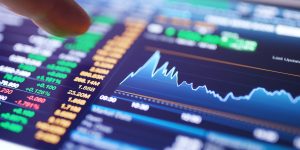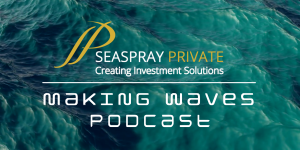Summary
Since our 2020 investment note in January, things around the world have changed dramatically, we have all been presented with a very unique situation which nobody could have foreseen. Many nations are now in full lockdown and massive travel restrictions are in place across every continent on the planet as a direct result of the unprecedented COVID-19 virus. Whilst our primary focus is everyone’s health during these difficult times, it is also extremely important to us that we deliver a first-class service and continue to advise our clients to the best of our ability in what currently may seem like very uncertain markets.
Volatility and uncertainty never feel good, but the foundation underlying them is important. Daily market moves in response to the COVID-19 outbreak have matched the scale of those seen during the financial crisis over a decade ago. But we must remind clients that this is not 2008. The coronavirus shock is not one caused by a crisis in the core of the financial system and spreading to the rest of the economy. The economy is on much stronger footing and the financial system is much more robust this time around. In fact, policy measures and safeguards put in place since 2008 have only served to strengthen the financial system.
So what is our current stance? We strive to remain objective throughout any stage of a cycle and focus on the facts. Decades of stock market history tell us “this too shall pass.” This, coupled with our own experience in capital markets, suggests that the most prudent tack for a long-term investor is to stay the course ― and to prepare for the opportunities that may arise as markets emerge from the turmoil in the coming weeks and months.
We are of the opinion that most of the COVID-19 related negativity and fears have already been priced into the market, if not the absolute worst-case scenario already having been priced in. Markets tend to live in the future and are always pricing in future events and scenarios. In light of this, we see a strong possibility that global equities could for the most part put in their longer- term lows just as (or just after) the UK and US reach their peaks in terms of new daily cases and deaths. There will soon come a point when everyone who wanted to sell, or was forced to sell, has done so. Only buyers will be left. “Be fearful when others are greedy, be greedy when others are fearful” comes to mind. We would also point out, that historically equity markets put in their lows 3-6 months before recessions end. We believe that we will be out of any recession and in recovery mode for the second half of the year.
We accept that the containment measures being taken across the globe to combat the virus will have a large economic impact. Global gross GDP growth will most likely be negative for Q1, and will enter the second quarter at risk of contracting further. However, we believe the global economy should be poised to rebound in the second half of 2020. The combination of unprecedented monetary and fiscal stimulus on top of last year’s global central-bank easing, in addition to the reduction in China-U.S. trade tensions, argues for a solid recovery when the virus threat recedes. If COVID-19 daily new cases and deaths continue to fall gradually in countries such as Spain and Italy, we would expect both the US and UK to peak in late April and subsequently follow the same path of slow but steady recovery. If and when this happens, we envisage that stock markets will quickly begin to price in a global recovery.
So, it is normal that markets will remain volatile and that many investors will focus on those risks, especially with earnings season approaching and all the noise that it brings with it. That being said, we still believe that in the second half of the year we will see a gradual global economic recovery after a weak first half. Why are we thinking this? Three key factors :
1. China has managed to stabilise the number of cases, so this should happen in the US and Europe.
2. We have monetary and fiscal stimulus already in place and still being delivered to a high degree.
3. The consumer around the world is in a relatively healthy financial state and labour markets are strong. So, as long as consumer risk appetite improves from where it currently is, consumption will pick up as well.
Taking a closer look at Q2: this quarter begins with solid arguments on both sides of the ledger. Pessimists will have a few months of depression-like economic data to highlight, as well as rising corporate bond default risks, plus sizeable downgrades to corporate earnings and dividend forecasts. They will also be able to point to the threat of a second wave of COVID-19 reinfections in China, as workers return to employment, and to the possibility of further second wave activity elsewhere when winter arrives. However, we expect that the extraordinary monetary and fiscal response that we have seen will lift the global economy back into expansion in H2 of 2020. In fact, many analysts are predicting that 2020 could see one of the shortest recessions ever. Still, the recovery will of course be slower than the descent and the global economy seems unlikely to fully recover from the coronavirus until well into next year.
One must take a step back and remember that this is what happens after the longest bull market run ever. The S&P climbed around 400% from its 2009 lows to its all-time high of around 3390. Names such as Amazon are still up over 1200%, despite a 20% pullback from its recent all-time high. As always, context is everything. This too shall pass, life will continue and eventually uncertainty and fear will fade away. After more education and curbing measures, time decay on virus concerns will set in. As the rest of the world catches up with what Asia went through in January and February, we forecast that fears will generally lessen.

Fiscal & Monetary Stimulus
Central Banks
Q1 saw a range of central banks aggressively cut interest rates and announce new asset purchasing programmes, some of which were out of schedule and were deemed ‘emergency rate cuts’. The Federal Reserve delivered two of these emergency cuts, bringing rates down to 0-0.25%. They have also restarted quantitative easing, promising asset purchasing with no set end date as of now. Additionally, the US’ central bank has brought in several lending facilities to ensure adequate liquidity, smooth functioning of the short-term funding markets, and access to credit. Areas most damaged by social distancing are not necessarily interest rate-sensitive sectors, so stimulative effects to the economy may be limited. However, these steps should help with liquidity and financial conditions.
The response of central banks to the unfolding crisis has been unprecedentedly large and swift. Also, governments have responded quickly and vigorously, introducing a wide range of fiscal relief programmes in the major economies. Needless to say, this stimulus has come at a very high fiscal price with the federal deficit likely to top $3 trillion or 15% of GDP this fiscal year before falling back next year.
In late March, Congress passed a $2 trillion economic relief and stimulus package that casts a lifeline to workers, small business owners, and other affected sectors of the economy, including restaurants, airlines, and healthcare systems. The program is massive, as it equates to roughly 10% of GDP.
As expectations for the U.S. fiscal stimulus package set in, the markets appear to have stabilized somewhat. However, major threats to the economy and markets will remain until the duration and impact of the economic slowdown and its impact on business solvency are well understood.
This recession and the new cycle will have their own distinct characteristics. Policymakers have responded more extensively than in any previous crisis, and just as easy monetary policy defined the last cycle, the extensive use of fiscal policy will define the next one. For now, monetary policy is the first responder to the crisis and will remain so until funding stresses recede, likely signaled by a sustained reversal of recent USD strength.
We cannot predict the long-term impact of the fiscal triage unleashed to support the real economy over recent weeks, but massive and ongoing fiscal support is surely required to address the prevailing deflationary pressures. Moreover, now the fiscal genie is out of the bottle, it will be hard to put back in. Thus, we expect fiscal stimulus to run alongside monetary stimulus well into the next expansion. This will underpin risk assets and in theory would launch equities back to all time highs within a number of years.
Given that the heart of the economic damage is with consumers and businesses, the U.S. government has put together a 2.2 trillion USD fiscal package to combat the impact of social distancing and target these areas specifically. Similar packages have been announced in the UK and EU.
This legislation will provide very significant but temporary help to individuals, companies and state and local governments, but it won’t be able to prevent the economy from falling into a sharp recession, in terms of lost output and higher unemployment. However, it should allow both households and companies to avoid the worst effects of recession until a vaccine has been developed and the economy can embark on a robust recovery.
Central banks have moved aggressively, setting up an array of programs with extraordinary speed to backstop various markets. Our analysts believe that banks have the will and the ability to prevent a major financial accident in the months ahead. However, unlimited liquidity support will not be enough. Much of the economic hit is falling on small and medium businesses, many of which cannot be helped through financial markets. Fortunately, policymakers recognize this and in major economies in the euro area, as well as the US, are planning stimulus of anywhere between 10-15% of GDP, including massive loan guarantees. The scale of the downturn and eventual recovery could depend on how effective governments are in supporting small and medium businesses in particular.
MMT
As we alluded to 3 months ago in our 2020 Investment Outlook, we may very well be in the new era of Modern Monetary Policy Theory. With the central bank policy tool box empty, we think we are on the verge of full MMT, when politicians take the reins from obsolete central banks and expand spending without constraint from debt issuance (true money printing!).
We are in the phase where policymakers will throw a lot of stimulus against the economy, including various lending programmes from governments and the extension of tax payments (which is essentially just swapping cash flows over time). Our view is that sentiment and asset prices should be lifted here due to all the stimulus. But then, as economic activity numbers are published investors will realise more is needed and equity markets could take one more leg lower in April. Policymakers have a record of always being behind the curve.
Markets are dealing with a health crisis that cannot be appeased by central banks. As the baton is passed to governments, who will be stepping up to provide cash directly to businesses and households, we enter a new regime. Whether the shockwaves of this event are truly enough to shift traditional industry thinking remains to be seen, but we should at least see a more broad-based approach to diversification over the long term, thus increasing exposure to the potential higher volatility regime shift.
Currencies
Our main expectation around currencies is that the safe-haven rally in the U.S. dollar could well unwind once we are in the post-virus recovery phase. This would favor currencies such as the Australian dollar, New Zealand dollar, Canadian dollar and British pound, which after significant depreciation are substantially undervalued at the end of the first quarter relative to long-term purchasing power parity comparisons.
The U.S. dollar remains a major headwind. Most emerging market currencies trade at historically low values compared to the U.S. dollar, which increases dollar-denominated costs for emerging market borrowers and is a headwind to growth prospects.
Regions
United States
The government’s virus containment measures mean a technical recession, negative GDP growth in Q1 and Q2 is probable in our opinion. From peak to current trough, the S&P 500 Index declined 35% from its 2020 peak, which is on par with a moderate economic recession. A massive amount of economic pain is already in the price.
Tailwinds from monetary and fiscal policy should eventually promote stronger economic conditions when the virus disruption has cleared. The upside risk is that should the number of new virus cases begin to decline in Q2, the subsequent recovery will be boosted by the strongest stimulus measures in more than a decade.
Europe
We believe that the eurozone is likely to experience a deeper recession than the US, but should also experience a bigger economic bounce when the virus subsides. We think the region will be one of the main beneficiaries of the rebound in global trade. We see eurozone equities as currently very attractively valued (for a long term investment), and we believe the European stock market could be one of the best performers in a recovery.
UK
In the UK, the COVID-19 declines have taken the FTSE 100 Index into exceptional value territory. It has a trailing PE ratio of under 10x, and a dividend yield pushing toward 7%. We believe the UK economy has two main advantages over Europe. First, the Bank of England has been able to cut interest rates to 0.1%. Second, the nation has the ability to quickly implement fiscal easing. However we still see longer term issues with regard to Brexit which has not gone away and will in time re-effect the UK
China
China was the first country to enter the COVID-19 crisis and see a downward trend in the number of new cases. High frequency trackers of daily economic activity show that economic activity is resuming. Traffic congestion in Shenzhen and Shanghai has returned to normal levels and coal consumption by power generators is trending higher. Government stimulus is coming. Local provinces have announced infrastructure projects, and the People’s Bank of China has cut interest rates and the reserve ratio requirement several times. Banks have been encouraged not to call in loans while there is pressure on cash flows. The main uncertainty is whether the combined monetary and fiscal stimulus will be as large as in 2015/16, which created a V-shaped recovery in 2016. We don’t think it will be nearly as large, as China’s leadership is still worried about excessive debt levels. But it will be substantial and position China for a strong rebound when the threat from the virus starts to subside.
Equities
We believe equity value has improved after the large market falls. The cycle outlook is supported by the substantial amount of stimulus being implemented, even though our near-term outlook is for recession. The message from our composite sentiment indicator is that investors have panicked and herded into a pessimistic outlook, which supports taking a contrarian view. The equity markets that have been hardest hit by the COVID-19 crisis should be those that benefit the most from the eventual rebound. Investors will need to see clear signs that large economies, including the US, have turned the corner on controlling the spread of the coronavirus before mounting a sustained rally.
We acknowledge that we could very easily see one more leg lower in April. Bear markets bring with them the risk of short squeezes, but we are anticipating a large hit to earnings. We like duration, where we expect weak growth to push yields lower. We retain a preference for USD-denominated cash, which may become useful as dry powder. We don’t own the broad market; we own a heavily researched group of stocks that we have conviction in for the long term. That can be reassuring when markets are anything but. Without question, some assets are oversold, and where policymakers have provided backstops – for instance, in higher quality credit – there are opportunities to selectively add risk. But for the time being, we acknowledge that conviction is likely to stay low and a cash buffer is important.
Opportunities exist in all market environments. Amid our cautious and conservative bias, we are mindful that opportunities exist within each asset class in all market environments. U.S. equities’ dividend income profile improved, with nearly 75 percent of S&P 500 companies offering dividends above the 10-year Treasury yield of 0.67 percent, as of March 31. Also, the digital transformation reflects change and investment opportunity. Artificial intelligence, machine learning, robotics and automation, and the electrification of work and play are among compelling investment opportunities for investors looking toward year-end 2020 and beyond.
One to avoid: leverage. Stocks with high debt ratios have underperformed in this downturn. While we would expect levered stocks to lead in a recovery, we would steer clear. If the slump is longer and more persistent than we expect, companies like these could suffer bankruptcy, resulting in a significant impairment to investor capital.
An area we’d like to visit is specifically to do with equity markets in two particular areas. The first relates to yield and dividend yield and the second relates to valuations.
➢ We believe that valuations in equity markets are reasonable in this point of the cycle. We say don’t invest in the broad market though because we believe it’s time to focus on quality companies as these offer good sustainable revenues and cash flows while offering a favourable risk return scenario.
➢ The second area is dividends and we believe, with the lower for longer scenario where interest rates remain low, that dividend yields on equity stocks are particularly attractive, especially those with sustainable dividend yields. We believe it’s very rational to invest in long-term investment themes given the trends we’re seeing in society, the broader economy and also in the markets. We believe these are sustainable for the long term and offer the best risk-reward given the markets.
However, with demand weakness lingering, it may well take a few years to get back to where we were and even longer for some economies. Moreover, the world that follows may be fundamentally different in many respects, such as the role of the state and the future of globalisation.
The US-China trade war already started disrupting supply and slowing growth over the last year. In Q1 2020 the world economy was hit by the COVID-19 virus outbreak, creating both a supply (Chinese lockdown) and demand (lockdowns in many countries) shock, in addition to an oil price war between Russia and Saudi Arabia which threatens to significantly impact the US oil industry and global investments in general. Not since 2008 has the world been this uncertain and out of balance. As equity prices reflect the future and growth prospects, they are the most sensitive to the current crisis. Investors are desperate to get out and cash in on years of fat profits.
2020 will technically be a recession year and thus fairly ugly for corporate profits, since corporate profits have traditionally been far more cyclical than the economy itself. However, in this recession, it will be particularly important to consider sectoral effects. For example, the energy sector will likely be hit very hard both by diminished global demand and ongoing production disputes. However, for investors it will be important to consider not just the downturn itself but also substantial efforts by the Federal Reserve and Federal Government to protect businesses in the recession. In addition, regardless of the depth of the recession, corporate profits should be able to bounce back in the recovery and S&P500 operating earnings per share may well exceed last year’s levels by 2022, thus setting a new all-time high.
US vs Europe
Within equities, the high quality of U.S. equities is attractive, and we remain cautious in the short term on European equities, whose links to the global cycle could be a headwind.
Steeper curves and greater fiscal intervention could also redefine equity market leadership over the next cycle: returns driven more by nominal earnings growth than multiple expansion, dividends preferred to buybacks, operating leverage rewarded more than financial leverage and value beginning to close the gap on growth. Depending on how effectively different countries and regions deploy fiscal stimulus, international equities could, over time, start to catch up to U.S. stocks.
The long-term growth prospects of EM economies still look better than for the U.S., valuations remain cheaper overseas and the dollar remains too high based on trade flows, suggesting an eventual dollar decline which would amplify the return on international equities. Moreover, it is worth noting that with risk assets down across the board, many investors in taxable accounts may be able, for the first time in many years, to reallocate among asset classes without triggering a substantial capital gains bill. U.S. and international stocks alike have sold off during this COVID-19 crisis, but the valuation gap between U.S. and international stocks that persisted throughout the recent expansion still persists today. However, this dynamic could shift in the next expansion.
Fixed Income
Sovereign Debt
Nominal Treasury yields have fallen to historic lows and real yields are negative when you adjust for inflation. This comes as no surprise after the Fed slashed interest rates to almost zero and announced numerous programs to support markets. At times in the first quarter, the Fed bought more government-backed bonds daily than they did monthly during and after the financial crisis of 2008. Other central banks across the globe took a variety of similar measures to ease strained financial conditions. We anticipate Treasury bond yields to remain low in the near term. In this low rate environment, we expect investors will continue to hunt for yield. While the downturn has caused high yield spreads to widen, defaults are likely to rise, so careful security selection is critical. Additionally, high-quality fixed income will continue to play an important role in providing investors with protection if the recession should deepen.
As growth slumps in 2020, we expect bond yields to fall further and for negative stock-bond correlation to reassert itself. But further out, fiscal stimulus together with low policy rates may ultimately have a bigger inflationary impulse than monetary policy alone, resulting in steeper yield curves at equilibrium.
Treasury bond returns were strong, while corporate and municipal bonds posted losses. Fed rate cuts and their significant bond buying programs, investor demand for safe-haven assets, collapsing inflation expectations and falling growth expectations all contributed to rising Treasury prices and falling yields.
Corporate Debt
Corporate bond yield spreads (corporate bond yields compared to Treasuries) traded at their widest levels since 2009, both in investment-grade and high yield categories. However, they are still a meaningful distance from the extremes of 2008. Spread levels are the widest in years but the bottoming process took a period of months during previous periods of extreme market stress. We haven’t seen the signs of stabilization needed to take a more aggressive stance at this point.
Commodities
Oil
All developments in the oil sector should be watched closely. The recent collapse in the price of oil initiated a shockwave of volatility that reached many other asset classes. Any signs of stability in oil prices should help to ease volatility across markets more broadly.
The global economy is currently dealing with the biggest demand shock since the global financial crisis, plus a global supply shock and an oil price war which is driving a destruction of capital. The lockdowns in China at the beginning of the outbreak have now spread to the rest of the world, most noticeably Europe and the US. The short to medium term result is going to be a slump in global growth, rising unemployment, and lower consumer confidence.
Given the fact that most oil producers (including Russia and Saudi Arabia) are currently selling at a price well below their budget break-evens, we will eventually see the market recover. However, before that happens the virus either needs to show signs of retreating or we need to see a meaningful and long-overdue reduction among high-cost production companies in places like the US and Brazil. In addition, the long road to recovery back towards the $50 to $60 range in Brent will be hampered by the rapid rise in global stocks. These will need to be reduced before Brent can recover.
The energy sector is structurally weak after years of trying to rebuild profitability and lower debt levels after the oil price collapse of 2014-2015, so it’s inevitable that some companies will disappear. Our view is that investors who want exposure to the energy sector should do it in the strongest energy companies and avoid the weakest. Our preferred company list, which we use to build our clients portfolios’ reflect these recommendations.
Gold
Gold’s failure to significantly rally as COVID-19 spread and economic uncertainty rose has brought back memories of 2008. During the early part of the financial crisis, all assets were sold as investors deleveraged to realise cash or pay for losses elsewhere. In the early weeks of the crisis, gold suffered a 27% sell-off to $725 per ounce before beginning an ascent which eventually took it to $1920.
The rally started in gold mining stocks before moving to gold and it took another few months before the stock market finally bottomed out. With this in mind, we are keeping a close eye on gold mining companies through the Vaneck Major Gold Miners ETF. We also have to keep in mind that the cost of fuel, which accounts for 20% of mining costs, has collapsed. Gold miners have therefore, at least for now, not suffered the hit that the drop in gold would otherwise imply.
We believe the long-term reasons for holding gold have, if anything, been strengthened by current developments. While official interest rates have been slashed, corporate bond yields have been rising. The broken transmission between central bank actions and developments on the ground is likely to trigger a major fiscal and potential inflationary response from governments around the world. US 10-year real yields, another major driver of gold, have risen sharply in response to much lower inflation expectations. We believe this move is unsustainable and that real yields will eventually move back into deeper negative territory.
The aggressive sell-off in crude oil hasn’t helped gold. The Russian central bank has been a strong buyer of the precious metal in recent years. That buying has now stopped and depending on how long it takes before crude oil recovers, we could potentially see Russia become a net-seller. After all, they will have to cover the shortfall of oil slumping below their budget break-even, which is somewhere close to $40 per barrel.
If you would like to discuss anything raised above or would like a review of your financial position, please do not hesitate to contact us
Tel: +353 1 70 70 000
or
info@seasprayFS.ie
Warning: The value of your investment may go down as well as up and you may lose some or all of the money you invest. Past performance is not a reliable guide to future performance. Investments denominated in a currency other than your base currency may be affected by changes in currency exchange rates.
This material is approved for distribution in Ireland by Seaspray Financial Services Ltd .It is intended for Irish retails clients only and is not intended for distribution to, or use by, any person in any country where such distribution or use would be contrary to local law or regulation. Seaspray Financial Services Ltd Ire (“SFS”) is regulated by the Central Bank of Ireland.
Where SFS wishes to make this and other Seaspray Financial Services Ltd research available to Retail clients, such information is provided without liability and in accordance with our terms and conditions that are available on the SFS website.
No report is intended to and does not constitute a personal recommendations or investment advice, nor does it provide the sole basis for any evaluation of the securities that may be the subject matter of the report. Specifically, the information contained in this report should not be taken as an offer or solicitation of investment advice, or to encourage the purchased or sale of any particular security. Not all recommendations are necessarily suitable for all investors and SFS recommend that specific advice should always be sought prior to investment, based on the particular circumstances of the investor either from your SFS investment adviser or another investment adviser.
SFS takes all responsibility to ensure that reasonable efforts are made to present accurate information but SFS gives no warranty or guarantee as to, and do not accept responsibility for, the correctness, completeness, timeliness or accuracy of the information provided or its transmission. This is entirely at the risk of the recipient of the report. Nor shall SFS, its subsidiaries, affiliates or parent company or any of their employees, directors or agents, be liable to for any losses, damages, costs, claims, demands or expenses of any kind whatsoever, whether direct or indirect, suffered or incurred in consequence of any use of, or reliance upon, the information. Any person acting on the information contained in this report does so entirely at his or her own risk
All estimates, views and opinions included in this research note constitute Seaspray Financial Services judgment as of the date of the note but may be subject to change without notice. Changes to assumptions may have a material impact on any recommendations made herein.
Unless specifically indicated to the contrary this research note has not been disclosed to the covered issuer(s) in advance of publication.
Past performance is not a reliable guide to future performance. The value of your investment may go down as well as up. Investments denominated in foreign currencies are subject to fluctuations in exchange rates, which may have an adverse affect on the value of the investments, sale proceeds, and on dividend or interest income. The income you get from your investment may go down as well as up. Figures quoted are estimates only; they are not a reliable guide to the future performance of this investment.
Conflicts of Interest & Share Ownership Policy
It is noted that research analysts’ compensation is impacted upon by overall firm profitability and accordingly may be affect ed to some extent by revenues arising other Seaspray Financial Services Ltd business units including Investment Management and Corporate Finance. Revenues in these business units may derive in part from the recommendations or views in this report. Notwithstanding, Seaspray Financial Services Ltd is satisfied that the objectivity of views and recommendations contained in this note has not been compromised. Nonetheless Seaspray Financial Services Ltd is satisfied that the impartiality of research, views and recommendations remains assured.
Analyst Certification
Each research analyst responsible for the content of this research note, in whole or in part, certifies that: (1) all of the views expressed accurately reflect his or her personal views about those securities or issuers; and (2) no part of his or her compensation was, is, or will be, directly or indirectly, related to the specific recommendations or views expressed by that research analyst in the research note.
We have assessed the publication and have classed it as Research under MIFID II. All charges in relation to this publication will be borne by Seaspray Financial Services Ltd
EON.







